AviClear Review: This Is the Biggest Acne Breakthrough in Years
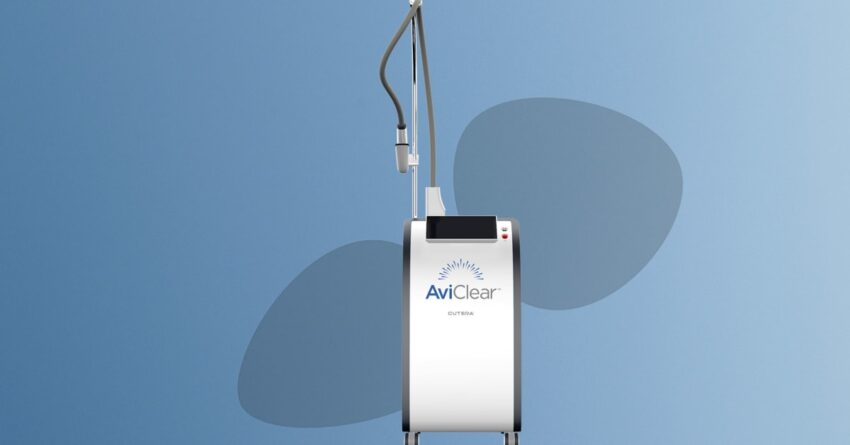
Men’s Journal aims to feature only the best products and services. We update when possible, but deals expire and prices can change. If you buy something via one of our links, we may earn a commission. Questions? Reach us at shop@mensjournal.com.
AviClear by Cutera is among the most exciting advancements in the treatment of acne, which impacts nearly 9.4 percent of the global population, making it the eighth-most prevalent disease in the world, per research published in the British Journal of Dermatology. While there’s no one prescription on how to get rid of acne, this first-of-its-kind laser acne treatment is regarded as the best alternative to Accutane in its ability to down-regulate sebaceous (oil) glands without the systemic side effects that make the drug such a deterrent.
After months of clinical trial evaluation, AviClear was approved by the FDA for the treatment of acne in March 2022. I found AviClear reviews online, but they were from people with hardly any acne to begin with. In light of this, it sparked AviClear Reddit forums for potential and current patients pining for real feedback, honest discussions, and candid before and after photos, which is where I found myself.
Acne has ebbed and flowed throughout my life: hormonal breakouts as a teen during puberty, again in my early 20s in college, a strange-and-fleeting bout of sun-triggered acne rosacea, and more cystic hormonal acne in my late 20s, early 30s. I’ve used moxycycline and doxycycline (tetracycline oral antibiotics), topical Aczone (dapsone gel), Spironolactone (only viable for women due to how it affects androgen receptors), Winlevi (topical Spiro that men can use), and retinoids including tretinoin and Aklief. Desperate, I spoke to my dermatologist about going on Accutane, but was advised against it due to anemia.
I’ve spent more money than I care to admit on facials, chemical peels, microneedling, and over-the-counter skincare with lofty claims to be cure-alls in a bottle. Tired of fixating on my skin and my monthly subscription of ZitSticka Goo Getter Hydrocolloid Patches, I paid Dr. Dennis Gross—a board-certified dermatologist and dermatologic surgeon who’s been practicing for 25 years—a visit at his New York City office to try the AviClear laser and stop my breakouts at the source. Here’s my review of the process, side effects, and results before and after for someone with moderate to severe acne.
What Causes Acne?
Acne forms when sebum, the oily substance on your skin, combines with dead skin cells and clogs your pores, trapping bacteria and spurring inflammation, per the Mayo Clinic. Oil glands have receptors for hormones, so any fluctuation can spur oil glands to produce oil that’s too heavy (think honey instead of water).
For men, testosterone is usually the culprit. There’s a positive correlation between testosterone and sebum levels. Because men produce more of the hormone, they tend to have over-stimulated oil glands, which can lead to clogged pores, causing breakouts.
For women, it can be attributed to estrogen and progesterone hormone fluctuations from birth control, the menstrual cycle, and hormonal imbalances, according to research published in the Journal of Clinical and Aesthetic Dermatology.
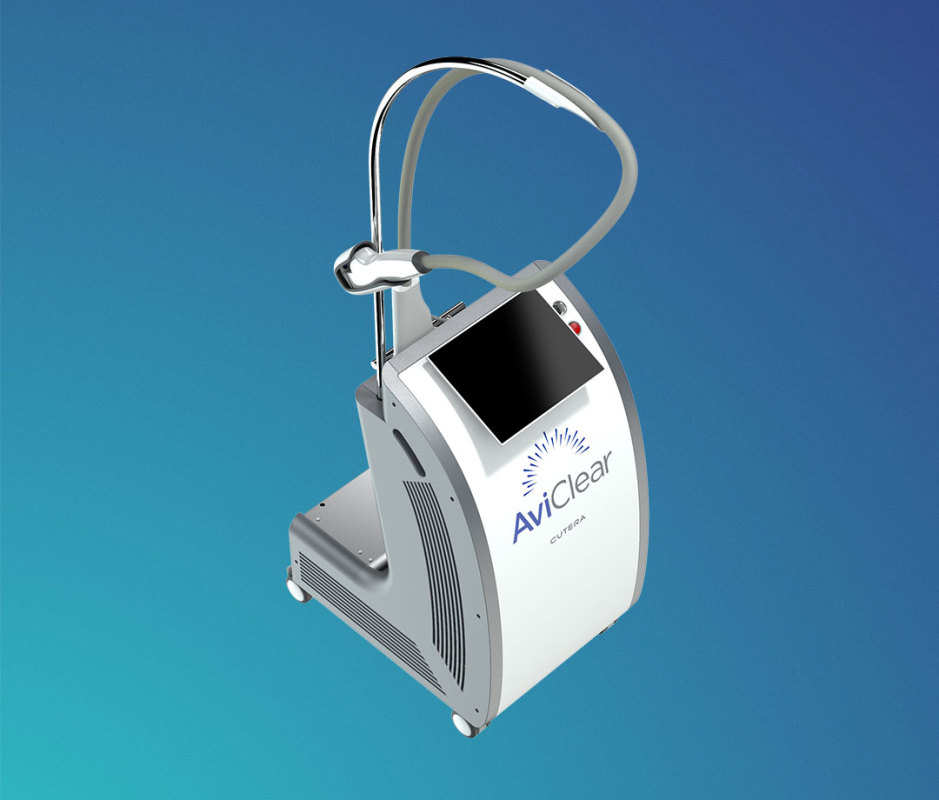
Courtesy Image
What Is AviClear and How Does AviClear Work?
“AviClear is a revolutionary treatment that uses a specific wavelength of 1726nm to target and suppress ‘sick’ oil glands that lead to acne,” says Gross. “In the past, we’ve had lasers with specific wavelengths that target skin issues like brown spots, redness, blood vessels, and laser hair removal, but there’s never been a type of laser that can target the oil glands,” Gross says.
The AviClear device is a diode laser similar to what’s used for laser hair removal. The difference is wavelength. During laser hair removal, the laser emits a light that’s absorbed by pigment in the hair, killing those cells. With the AviClear laser, it’s preferentially targeting oil glands. The machine uses an exact frequency to damage sebocytes, the major type of cell in sebaceous glands, and down-regulate sebum production.
This creates a domino effect, as less oil is produced that’s clogging pores and causing acne. While Accutane also works by shrinking and down-regulating oil glands, it’s systemic, often causing excessive dryness of your lips and body skin.
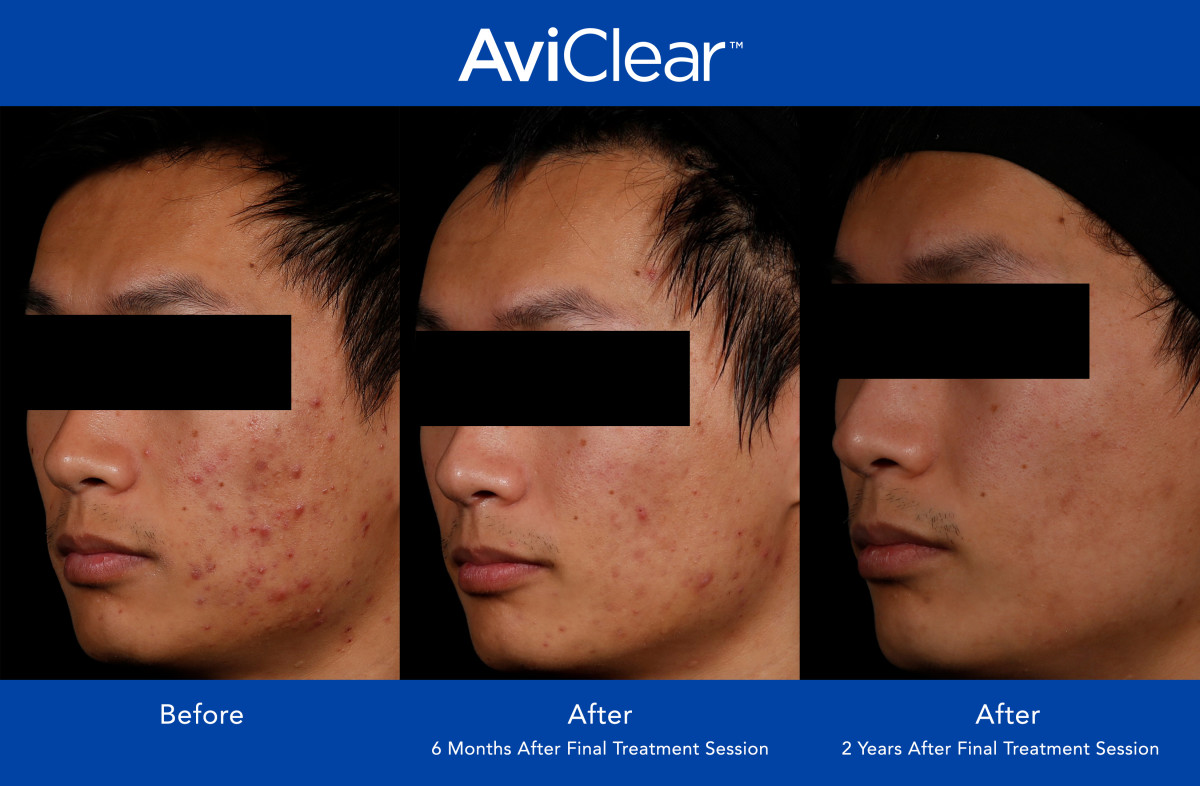
Courtesy Image
Who Is AviClear Good For?
Acne prevalence by the numbers is staggering. In westernized societies, acne has reached near-universal status. Roughly 79 to 95 percent of teens and 40 to 54 percent of adults older than 25 suffer from some degree of acne, while 12 percent of women and 3 percent of men in middle age are persistently afflicted by the skin condition, according to data published in Archives of Dermatological Research, a peer-reviewed international journal.
An FDA briefing doc cites the estimated total number of isotretinoin prescriptions dispensed from U.S. retail and mail-order/specialty pharmacies was 2,006,298 for men and women in the U.S. in 2022.
Moreover, the number of men seeking out isotretinoin prescriptions increased during the pandemic, as men were more likely to utilize telehealth, according to a 2023 analysis published in Archives of Dermatological Research.
Most oral treatments for moderate to severe acne have constraints. For instance, only women can take Spironolactone as it can cause low androgen levels and hypogonadism in males. Long-term antibiotic use can create resistance. And Accutane has serious side effects for both men and women. AviClear, on the other hand, is inherently less risky because it’s not a pill that impacts your body systemically. Here’s a look at side effects of the most common acne treatments.
| Oral Drug Name/Type | Pros | Cons |
|---|---|---|
Doxycycline and Minocycline (tetracycline antibiotics) | Inhibits bacterial growth and has an anti-inflammatory effect. | Suitable for men and women. Can make birth control pills less effective, only suitable for short-term use in case of antibiotic resistance. |
Spironolactone (anti-androgen) | Helps control hormonal acne by blocking the effects of androgens and progesterone on the skin. | Only suitable for women, is a diuretic, causes breast tenderness and high potassium levels. |
Birth Control (Progestin/Estrogen) | Lowers severity of acne flareups by lowering the amount of androgens in the body. | Only suitable for women, may cause depression and mood changes. |
Isotretinoin (Retinoid/vitamin A derivative) | Increases cell turnover and shedding of dead skin cells to mitigate clogged pores and reduces oil gland size and production by up to 90 percent. | Suitable for men and women, but side effects include dry skin and lips, dry mouth, joint pain, birth defects if women become pregnant (need to be on two forms of birth control), mental health problems, stomach issues. Patients must get blood work each month to ensure women aren’t pregnant and all patients’ kidney and liver function is optimal. |
There’s no age limit for AviClear, making it suitable for teens and adults, men and women, all skin tones and types, symptoms ranging from mild to severe acne, and all acne-prone body parts (chest, back, face, etc.).
Is AviClear Safe? What Are the Side Effects?
Not everybody is a good candidate for traditional laser treatments. For instance, darker skin types are more prone to side effects like hyperpigmentation and scarring, but that’s not the case with AviClear. It’s safe for all skin tones and types. As noted, there are no systemic side effects like Accutane.
Accutane has been the most controversial acne treatment, especially for women, as it’s linked to a high likelihood of birth defects. For men and women, side effects may include depression, thoughts of suicide, and inflammatory bowel disease.
“Due to the side effects, Accutane has always been a last resort for me,” Gross says. “AviClear provides just as good, if not better, results than Accutane without the negative side effects, so it’s a no-brainer.”
In the AviClear by Cutera clinical trial study for FDA clearance, 104 subjects (59 female, 45 male), aged 16 to 40 years, with mild, moderate, and severe acne underwent the AviClear laser procedure across seven U.S. sites.
During the clinical trial, there were no reports of blistering, hyper- or hypopigmentation, or scarring. Here are common AviClear side effects.
1. Temporary Redness and Swelling
The most common side effects are erythema (superficial reddening of the skin) and edema (swelling). All subjects experienced mild erythema, while 98 percent experienced edema, which are both expected and typical for laser therapy, and the occurrences resolved within several hours to several days post-treatment.
2. AviClear Purge
If you’ve done some research, you’ve likely heard about the AviClear purge. Similar to Accutane, your skin will get worse before it gets better. In the clinical trial, 45 percent of patients experienced mild purging—though scientists noted those with more severe acne had more severe purges after one or all three of the treatments. Think of it this way: Everything stuck in your pores needs to come out for clear skin. Stick it out and complete all three sessions for optimal results.
3. Dryness
About 18 percent of AviClear patients noted having dryness, and the trend was higher in women than men. Isolated occurrences of mild itchiness and skin sensitivity were also reported. That said, “you don’t see the same side effects of extreme dryness as you would from Accutane,” Gross says.
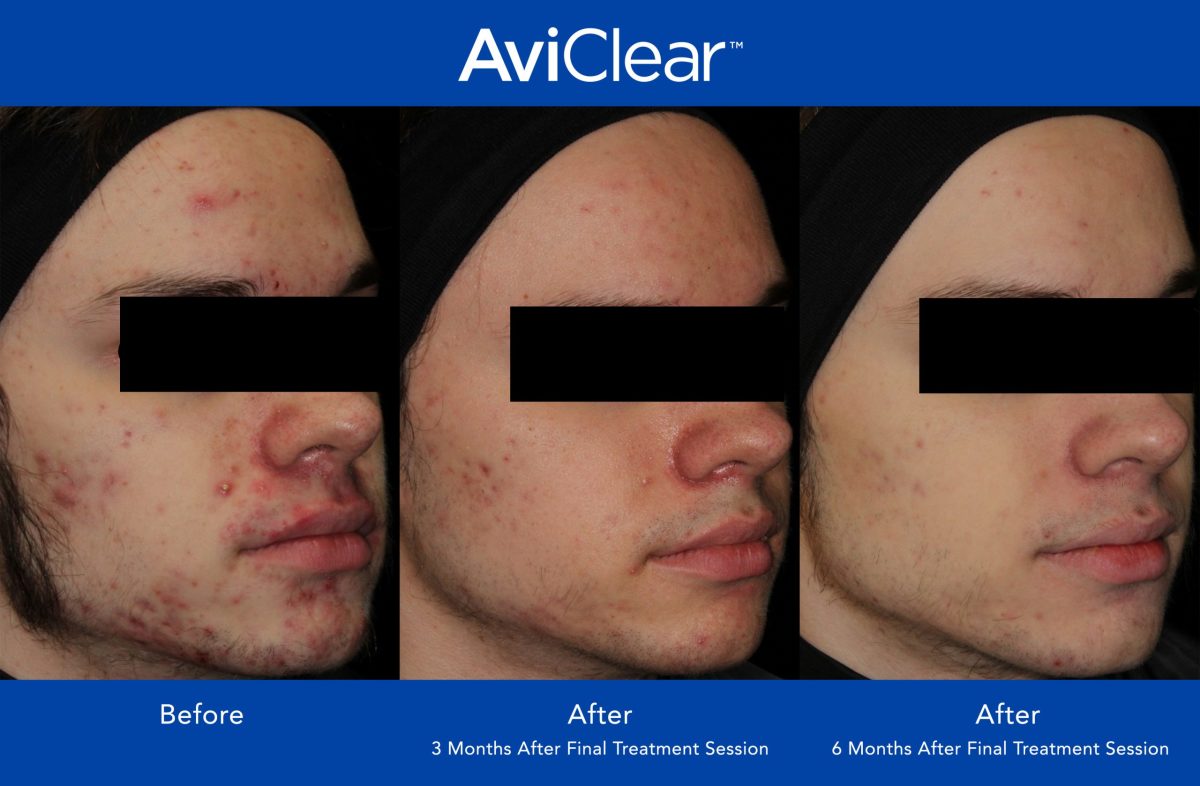
Courtesy of Cutera
How Long Does AviClear Last? Is It as Effective as Accutane?
Typically we never say something can cure acne, but AviClear is providing long-term results after just three treatments, Gross says. It’s effective in treating genetic and hormonal acne, too, which is historically difficult to treat.
In the AviClear by Cutera clinical trial study, 90 percent of patients experienced visible improvement in their acne six months after completing all three AviClear laser sessions. At the 12-month mark, that improvement increased to 92 percent, confirming long-term efficacy over time.
For Accutane, 85 percent of patients who take an oral dose of 0.5 to 1.0 mg/kg/day are virtually clear of their acne at four months, 13 percent require five or six months to clear, and 3 percent require a longer course, according to scientific literature on the use of isotretinoin in acne published in Dermato Endocrinology. Low-dose courses of isotretinoin are an option for mature adults with persistent and late-onset acne, too. Ninety-one percent were clear of acne using this regimen, but researchers note that relapse is frustratingly common.
The rate of relapse is 37 percent with a median timeline of 10 months, according to a 2021 study published in Dermatologic Therapy. The instance was higher in younger patients, which was also found in a 2007 case-control analysis using Quebec’s hospital discharge administrative databases comprising 17,351 first-time isotretinoin users was assembled between 1984 and 2003. Among patients who completed Accutane, 7,100 (41 percent) subjects experienced an acne relapse. Of those patients, being male, under the age of 16, living in an urban area, receiving isotretinoin cumulative doses greater than 2,450mg, and undergoing treatment for more than 121 days were statistically associated with acne relapse.
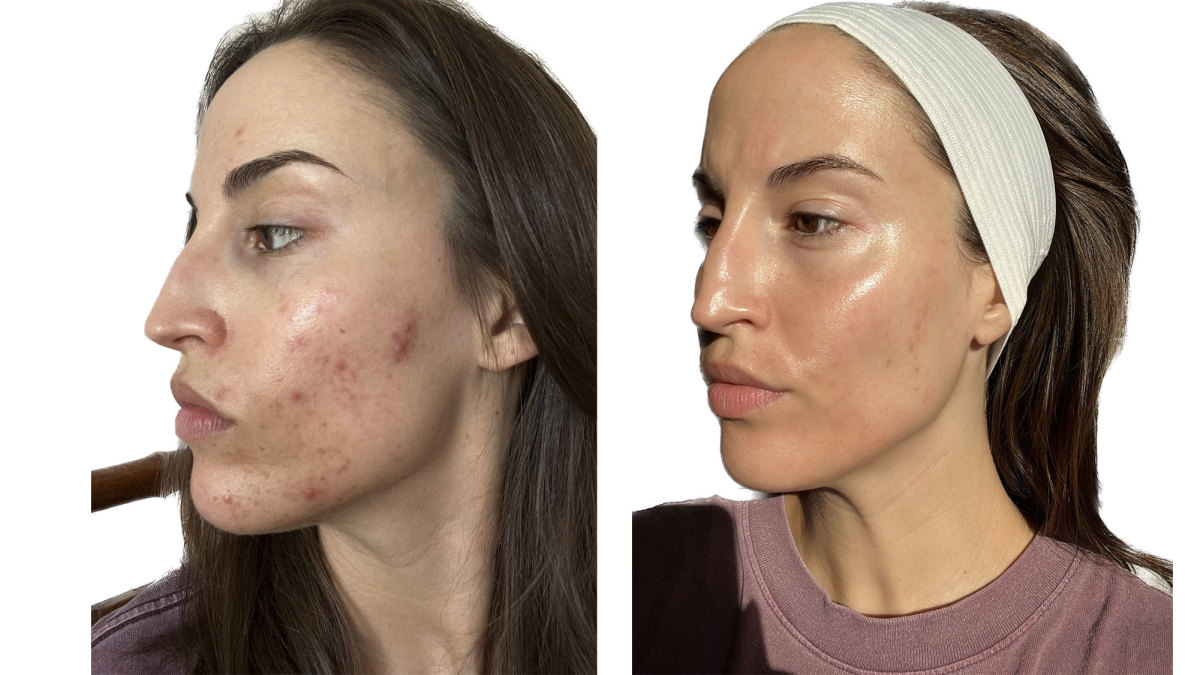 One week after third AviClear treatment versus three months after final treatment and three microneedling sessions.
One week after third AviClear treatment versus three months after final treatment and three microneedling sessions.
Brittany Smith
My AviClear Review
I first met with Gross on March 23, 2023, for my consultation and first AviClear laser treatment. We discussed my previous topical and oral drug history and family history of acne, after which Gross deduced I’m genetically predisposed to acne and suffering from hormonal breakouts (this type appears along the jaw and cheeks). He detailed his plan for me with Lia Trojansky, PA-C, who performed all the procedures.
Gross recommended I increase my dose of Spironolactone to 100mg (therapy dose for acne) and prescribed Minocycline for two to four weeks to help mitigate the AviClear purge.
AviClear Laser Treatment 1
Photos of my face were taken at varying angles to map my progress after each treatment, then Trojansky adjusted the treatment chair to lay me flat, and prepped my face with medical-grade acetone to remove any natural oils and sunscreen. She wore protective sunglasses while I donned eye goggles to protect against the laser. To protect from burns, wet gauze is placed over the skin to moisten it before and during the procedure. She kept a bowl of water nearby to re-wet the gauze periodically.
What to Do Before an AviClear Laser Treatment
- Avoid sun exposure (including tanning beds, artificial tanning).
- Up to five days before treatment, avoid skincare with irritating/active ingredients, such as tretinoin, retinol, benzoyl peroxide, glycolic/salicylic acids, etc.
- Avoid waxing and any other skin treatments that may irritate the skin, but men need to shave on the day of the procedure.
“AviClear is equipped with exclusive AviCool™ sapphire contact skin cooling and sensory controls that maintain the skin’s temperature during treatment for a more comfortable experience,” Gross says.
Trojansky started the laser by my ear and the base of my jaw, pressing the icy nozzle firmly against my skin until a beep indicated even pressure—the dermatologic equivalent of a green light.
I like to think I have a high threshold for pain. The first zap was tolerable, but similar to laser hair removal, some areas are more painful than others. I found my cheeks to be the easiest, virtually painless, but bonier areas like my cheek bones, jaw line, around my nose and eyes sockets, and forehead to be quite painful.
“The laser itself feels a bit like a rubber band snapping against the skin,” Gross says. I’d liken it to more of a needle-like sensation. All in all, the procedure takes 30 to 40 minutes to complete the entire face. With the goal of clear skin, the discomfort is absolutely worth it. Women can time their appointments so they don’t fall on their period, when they’re more sensitive to pain, and both men and women can take two Tylenol 45 minutes before the treatment, Gross says. Trojansky has had patients who’ve requested to take breaks and even inquired about laughing gas.
I focused on deep breathing—inhaling before the laser and exhaling with each zap—and found talking to Trojansky helped keep me distracted.
After the AviClear session, Trojansky set me up with an LED treatment: 15 minutes under blue light to kill acne-causing bacteria and 15 minutes under red light to reduce inflammation. There are quite a few LED light masks you can buy for at-home use, including Gross’s DRx SpectaLite FaceWare Pro that has three settings: red, blue, and a combo of the two.
Immediately after I had little to no redness. The edema/swelling just made my skin look a little more plumped, which was certainly not a bad thing. I applied sunscreen and scheduled my remaining appointments.
“There’s no downtime post-treatment, although you may see a flare-up before acne improves,” Gross told me.
He was right on both fronts.
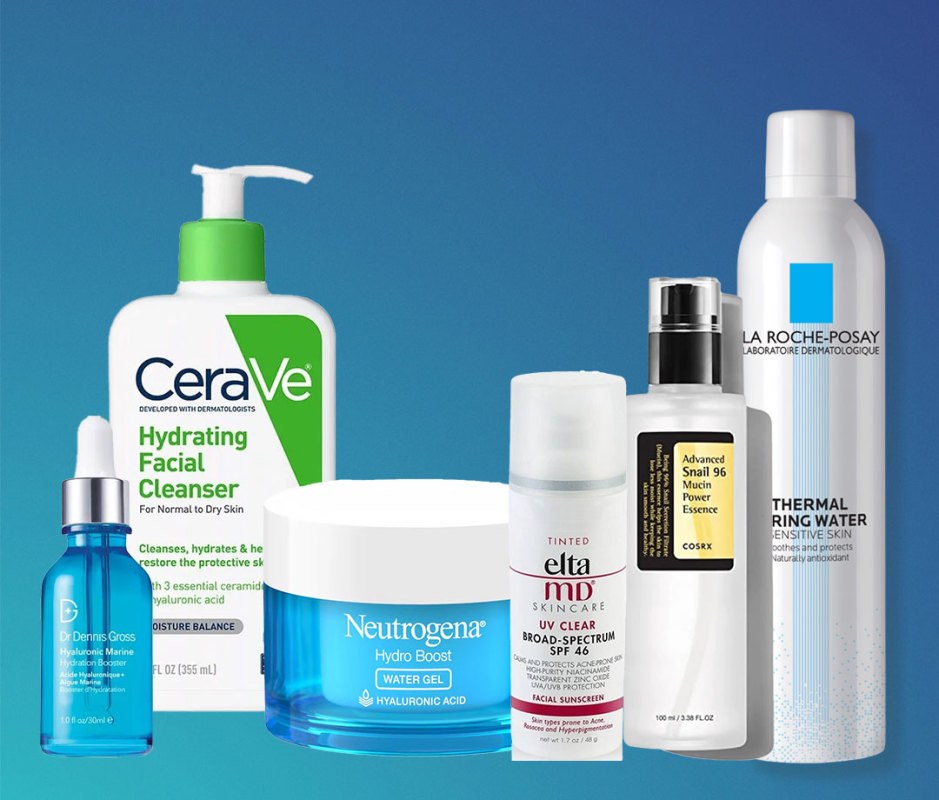
Courtesy Images
What to Expect After an AviClear Laser Treatment
Similar to the protocol pre-treatment, you want to avoid sun exposure and use gentle cleansers and non-active topicals, Trojansky says. You want to focus on skincare that enhances recovery and hydration. For the first five days after my session, I followed this soothing skincare routine:
- Cleanse face with lukewarm water and a mild cleanser like CeraVe Hydrating Facial Cleanser, then air-dry skin (you can also use a clean towel but make sure you swap yours out every few days since bacteria can build up).
- Use DRx SpectaLite FaceWare Pro (optional).
- Moisten face with La Roche-Posay Thermal Spring Water to make the skin more permeable. Hyaluronic acid should always go on damp skin.
- Apply Dr Dennis Gross Hyaluronic Marine™ Hydration Booster, then COSRX Snail Mucin 96% Power Repairing Essence to repair the skin barrier and boost hydration.
- Apply Neutrogena Hydroboost Hyaluronic Acid Hydrating Gel Cream Moisturizer
- Finish off with EltaMD UV Clear Face Sunscreen, SPF 46 in the daytime (use any oil-free sunscreen safe for sensitive, acne-prone skin).
- At night, follow the same procedure, but skip the sunscreen and apply a generous amount of a thicker cream instead to seal in moisture like La Roche-Posay Cicaplast Balm B5.
The day after my first treatment, my skin was already reacting. It was itchy, dry, and red. Small pustules formed on my chin and the cystic acne along and under my jaw started purging, some becoming blister-like. This lasted for two weeks. My skin was angry, inflamed, and congested, but this was all to be expected, according to Gross and Trojansky. It needs to surface, I reminded myself, each time I went through a sheet of ZitSticka Goo Getter Hydrocolloid Patches, fighting the urge to pick.
Because of the AviClear purge, Gross recommended coming in at the two-week mark in between my AviClear appointments for Cutera’s Excel V+ (Laser Genesis), another laser device, to address the pigmented lesions, active breakouts, and scarring, as well as extractions and a light chemical peel to aid cell turnover.
He also prescribed a benzoyl peroxide and clindamycin topical to help kill bacteria on the skin for use at night.
AviClear Laser Treatment 2
The pain level for the second session was comparable, if not a bit more painful. The intensity of the laser is increased each session. By this time, I was off Minocycline, still taking 100mg of Spironolactone, and underwent the same procedure: AviClear laser, LED light, followed by Cutera’s Excel V+ laser and a chemical peel two weeks after.
I still experienced purging for up to seven days after the treatment. It was slightly less intense and the larger cystic breakouts had flattened.
AviClear Laser Treatment 3
I was excited to be finishing the third round of treatment. Pain aside, I was eager to see some real results. My purge after this round was comparable to the first. Similar to when you have a zit appear in the same spot again and again, inflammatory pustules erupted along my cheeks (no doubt where the overactive oil glands reside), and my skin was red and bumpy. Two and three weeks out, my skin calmed down considerably. It was brighter and the active breakouts were subsiding.
I had a consultation with Gross wherein he recommended I return a month later for another one-two punch of Excel V+ laser and a chemical peel, followed by three rounds of microneedling to address acne scars.
Here’s a look at my treatment calendar/schedule:
| Date | Treatment |
|---|---|
March 23 | AviClear Session 1 |
April 7 | Excel V+/Laser Genesis and chemical peel |
April 21 | AviClear Session 2 |
May 5 | Excel V+/Laser Genesis and chemical peel |
May 19 | AviClear Session 3 |
June 27 | Secret RF Microneedling |
July 25 | Secret RF Microneedling |
August 29 | Secret RF Microneedling |
How to Boost Results From AviClear
Gross likes to combine professional treatments with prescription and over-the-counter topicals for patients to receive the best results. Speak to your dermatologist and AviClear provider to find the best treatment plan for your skin.
Professional treatments are costly. There’s no beating around the bush. If you have the money to spend, you’ll see the quickest results from combining the AviClear laser with the following:
- Excel V+ (Laser Genesis): The heat-based YAG laser helps treat inflammatory acne and kick-starts collagen production to reduce acne scarring.
- Secret RF: This type of microneedling uses controlled radio frequency energy to heat the deeper layers of the skin. The needles create micro-trauma to the skin, breaking up scar tissue and spurring new collagen, essentially resurfacing your skin.
- Chemical Peels: There are chemical peels of varying strengths and combinations (e.g. lactic and salicylic acid), but if you’re looking for an affordable alternative, incorporate Alpha Beta Daily Peels into your at-home regimen. “They’re formulated with a cocktail of alpha and beta hydroxy acids that dissolve dead skin cells and clear the pores’ lining to prevent breakouts while also delivering anti-aging benefits,” Gross says.
Now, just because I’ve done AviClear doesn’t mean I’m not using topicals suited to acne. Again, speak to your dermatologist to see what topical is best for your skin’s needs. The most common include:
- Retinoids/tretinoin like Retin-A Micro: cell turnover
- Azelaic and salicylic..

